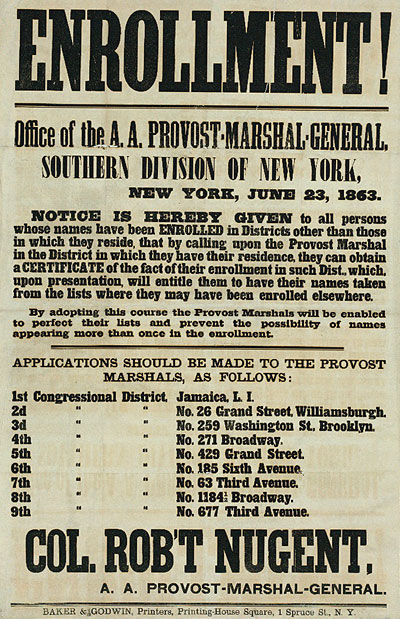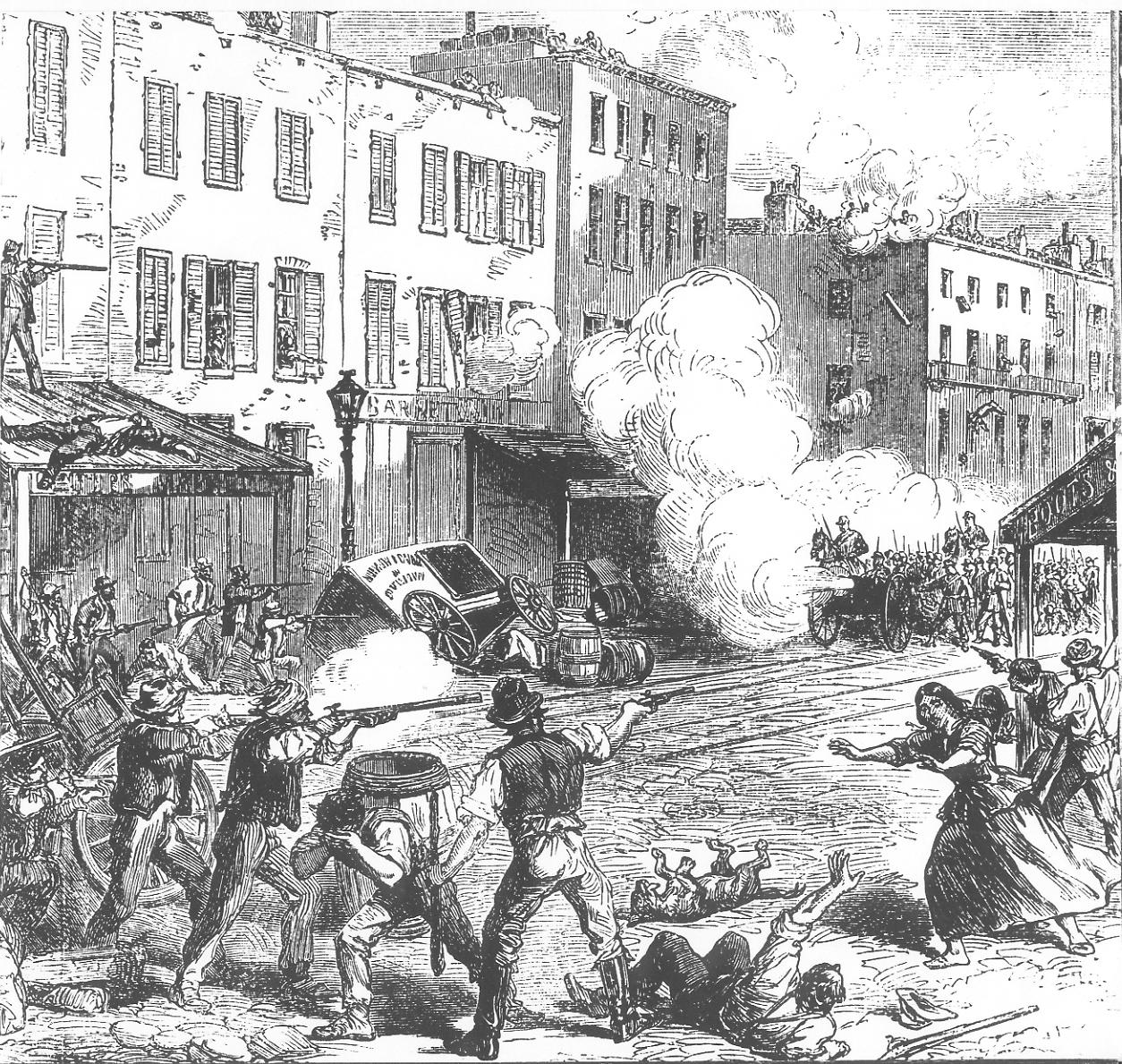Enrollment Act on:
[Wikipedia]
[Google]
[Amazon]
The Enrollment Act of 1863 (, enacted March 3, 1863) also known as the Civil War Military Draft Act, was an Act passed by the
 The
The
 The policies of substitution and commutation were controversial practices that allowed drafted citizens to opt out of service by either furnishing a suitable substitute to take their place or paying $300. Both provisions were created to soften the effect of the draft on
The policies of substitution and commutation were controversial practices that allowed drafted citizens to opt out of service by either furnishing a suitable substitute to take their place or paying $300. Both provisions were created to soften the effect of the draft on
Congressional Record
- A full text of version of the 1863 Enrollment Act
Commentary on the 1863 Enrollment Act
on Answers.com
Enrollment Act Riots
on MrLincolnAndNewYork.org
Map of Riot Locations
- "Mr Lincoln and New York" web site (under grant from The Lehrman Institute) United States federal defense and national security legislation Washington, D.C., in the American Civil War 1863 in law 1863 in the United States 37th United States Congress Conscription in the United States Conscription law
United States Congress
The United States Congress is the legislature of the federal government of the United States. It is bicameral, composed of a lower body, the House of Representatives, and an upper body, the Senate. It meets in the U.S. Capitol in Washing ...
during the American Civil War
The American Civil War (April 12, 1861 – May 26, 1865; also known by other names) was a civil war in the United States. It was fought between the Union ("the North") and the Confederacy ("the South"), the latter formed by states th ...
to provide fresh manpower for the Union Army
During the American Civil War, the Union Army, also known as the Federal Army and the Northern Army, referring to the United States Army, was the land force that fought to preserve the Union (American Civil War), Union of the collective U.S. st ...
. The Act was the first genuine national conscription law. The law required the enrollment of every male citizen and those immigrants (aliens) who had filed for citizenship, between 20 and 45 years of age, unless exempted by the Act. The Act replaced the Militia Act of 1862
The Militia Act of 1862 (, enacted July 17, 1862) was an Act of the 37th United States Congress, during the American Civil War, that authorized a militia draft within a state when the state could not meet its quota with volunteers. The Act, fo ...
.
It set up under the Union Army an elaborate machine for enrolling and drafting men for conscription. Quotas were assigned in each state, and each congressional district, with deficiencies in volunteers being met by conscription.
In some cities, particularly New York City
New York, often called New York City or NYC, is the List of United States cities by population, most populous city in the United States. With a 2020 population of 8,804,190 distributed over , New York City is also the L ...
, enforcement of the act sparked civil unrest
Civil disorder, also known as civil disturbance, civil unrest, or social unrest is a situation arising from a mass act of civil disobedience (such as a demonstration, riot, strike, or unlawful assembly) in which law enforcement has difficulty m ...
as the war dragged on, leading to the New York City draft riots
The New York City draft riots (July 13–16, 1863), sometimes referred to as the Manhattan draft riots and known at the time as Draft Week, were violent disturbances in Lower Manhattan, widely regarded as the culmination of white working-cla ...
on July 13–16, 1863.
Organization
 The
The Provost Marshal General
The provost marshal general (pronounced "provo") is a United States Army staff position that handles investigations of U.S. Army personnel. It is the highest-ranking provost marshal position in the U.S. Army, reporting to the Chief of Staff of ...
was recreated to administer the national implementation of the Enrollment Act. James Barnet Fry was appointed to the position and answered directly to Secretary of War
The secretary of war was a member of the U.S. president's Cabinet, beginning with George Washington's administration. A similar position, called either "Secretary at War" or "Secretary of War", had been appointed to serve the Congress of the ...
Edwin Stanton
Edwin McMasters Stanton (December 19, 1814December 24, 1869) was an American lawyer and politician who served as U.S. Secretary of War under the Lincoln Administration during most of the American Civil War. Stanton's management helped organize t ...
. Beneath Fry were the State Acting Assistant Provost Marshal Generals. The State Provost Marshal Generals were not authorized by the Enrollment Act, but were appointed personally by Fry to attend to matters in each individual state. New York and Pennsylvania were the only states that had more than one State Acting Assistant Marshal General; New York had three and Pennsylvania had two. Each state was divided along district lines with each district under the jurisdiction of an enrollment board.
Enrollment boards were headed by a district provost marshal and also included a surgeon and a commissioner. Each board employed clerks, deputies, and special agents as needed. They were divided into sub-districts along ward (in cities) and township (in rural areas) lines. In each sub-district a census was conducted by an enrollment officer to document every man eligible for the draft in the sub-district.
Criticism
 The policies of substitution and commutation were controversial practices that allowed drafted citizens to opt out of service by either furnishing a suitable substitute to take their place or paying $300. Both provisions were created to soften the effect of the draft on
The policies of substitution and commutation were controversial practices that allowed drafted citizens to opt out of service by either furnishing a suitable substitute to take their place or paying $300. Both provisions were created to soften the effect of the draft on pacifists
Pacifism is the opposition or resistance to war, militarism (including conscription and mandatory military service) or violence. Pacifists generally reject theories of Just War. The word ''pacifism'' was coined by the French peace campaigne ...
, the anti-draft movement, and the propertied classes. The result, however, was general public resentment of both policies. The two practices were major points of contention among the general public and led directly to the slogan "rich man's war, poor man's fight."
Substitution
Substitutions were available throughout the war. The problem with substitution was that it provided substitutes with powerful incentives todesert
A desert is a barren area of landscape where little precipitation occurs and, consequently, living conditions are hostile for plant and animal life. The lack of vegetation exposes the unprotected surface of the ground to denudation. About on ...
soon after enlisting. Career "jumpers" made a living by enlisting as a substitute, collecting their compensation, deserting before their units were dispatched to the front, and repeating the process. The problem was well known to the military commanders who regularly saw the same recruits. In addition, troops furnished by substitution were considered to be of an inferior quality in comparison to regulars and volunteers.
Commutation
Commutation (paying $300 to escape the draft, roughly the equivalent of $5,000 earned by an unskilled worker in 2018) was created in an effort to keep substitution prices low. If commutation were not instated, the price of a substitute would have quickly soared past $300. Also, commutation was intended to raise money for the war effort. While commutation raised war funds, it was often a criticism of the draft that it was better at raising money than troops. The rationalization for commutation was that unwilling troops were ineffective and so the government might as well extract funds from the unwilling if it got poor service. Despite the good intentions behind commutation, it was one of the most hated policies of the war.Amendments
1864 amendment
Section 5 of the Enrollment Act of 1864 limited the length of an exemption from the draft by payment of the commutation fee to one year, after which those drafted were required to serve or to furnish a substitute.1865 amendment
Section 21 of the Enrollment Act of 1865 (, passed on March 3, 1865), imposed denationalization (loss of citizenship) as a penalty fordraft evasion
Draft evasion is any successful attempt to elude a government-imposed obligation to serve in the military forces of one's nation. Sometimes draft evasion involves refusing to comply with the military draft laws of one's nation. Illegal draft ev ...
or desertion. In ''Afroyim v. Rusk
''Afroyim v. Rusk'', 387 U.S. 253 (1967), was a landmark decision of the Supreme Court of the United States, which ruled that citizens of the United States may not be deprived of their citizenship involuntarily. The U.S. government had attemp ...
'' (1967), Justice John Marshall Harlan II
John Marshall Harlan (May 20, 1899 – December 29, 1971) was an American lawyer and jurist who served as an associate justice of the U.S. Supreme Court from 1955 to 1971. Harlan is usually called John Marshall Harlan II to distinguish him ...
's dissent mentioned the Enrollment Act of 1865 as an example of a law in which citizenship could be revoked without a person's consent and that the Congress regarded as constitutional.
See also
* ''Gangs of New York
''Gangs of New York'' is a 2002 American epic historical drama film directed by Martin Scorsese and written by Jay Cocks, Steven Zaillian and Kenneth Lonergan, based on Herbert Asbury's 1927 book ''The Gangs of New York''. The film stars Le ...
'' – a film depicting the riots the Act caused in New York City
* Conscription in the United States
In the United States, military conscription, commonly known as the draft, has been employed by the U.S. federal government in six conflicts: the American Revolutionary War, the American Civil War, World War I, World War II, the Korean War, a ...
References
Bibliography
* * * * *External links
{{WikisourceCongressional Record
- A full text of version of the 1863 Enrollment Act
Commentary on the 1863 Enrollment Act
on Answers.com
Enrollment Act Riots
on MrLincolnAndNewYork.org
Map of Riot Locations
- "Mr Lincoln and New York" web site (under grant from The Lehrman Institute) United States federal defense and national security legislation Washington, D.C., in the American Civil War 1863 in law 1863 in the United States 37th United States Congress Conscription in the United States Conscription law